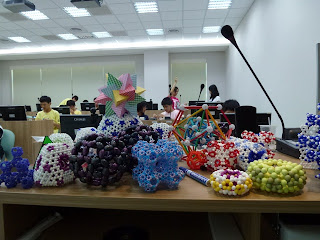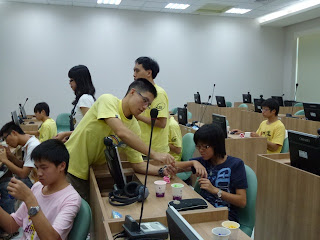I offered a summer camp (
繽紛多彩石墨烯─結構與模型, Amazing graphitic structures or
here) on creating structures and models of graphitic materials using a number of different techniques for high-school students in
Taichung these few days (7/5-7/7).
Three different techniques we used in this mini-workshop are the mathematical beading (one and half days), modular origami based on
PHiZZ units (half day) and zometool (half day).
1. 7/5 morning: Students learned the structures of Platonic solids and created bead models of tetrahedron, cube, dodecahedron (C20), and C24. I found that it is very useful to construct these simple trivalent Platonic solids first using beads with rod-like shape. With this, students can become familiar with the basic technique of right-angle weave.
2. The projects for the 7/5 afternoon is to construct bead models of C60 and C80. Most students can finish these projects in three hours.
3. 7/6 morning: Chern spent an hour to explain the molecular structures with jmol (a powerful program for visualizing any kind of molecular structure) first. Particularly, we use C60, T120 and so on as examples. In the next two hours, students started to make bead model of T120. All students succeeded in making their own beaded T120.
4. 7/6 afternoon: We switched to modular origami using PHiZZ units. The only project for this part is to make a dodecahedron.
5. We planned to build a giant concentered multilayer carbon onion consisting of 6 layer of icosahedral fullerenes using the Zometool tomorrow morning (7/7).
Participants:
1. TAs: Chern Chuang, Yuan-Chia Fan and Qian-Rui Huang.
2. twelve students from Taipei (2), Taichung (5), Changhua (4), and Tainan (1)..
Here are a few photos from the camp.


Two T120s that were constructed by students:







 (High-genus fullerene with octagonal necks, No:4)
(High-genus fullerene with octagonal necks, No:4)






